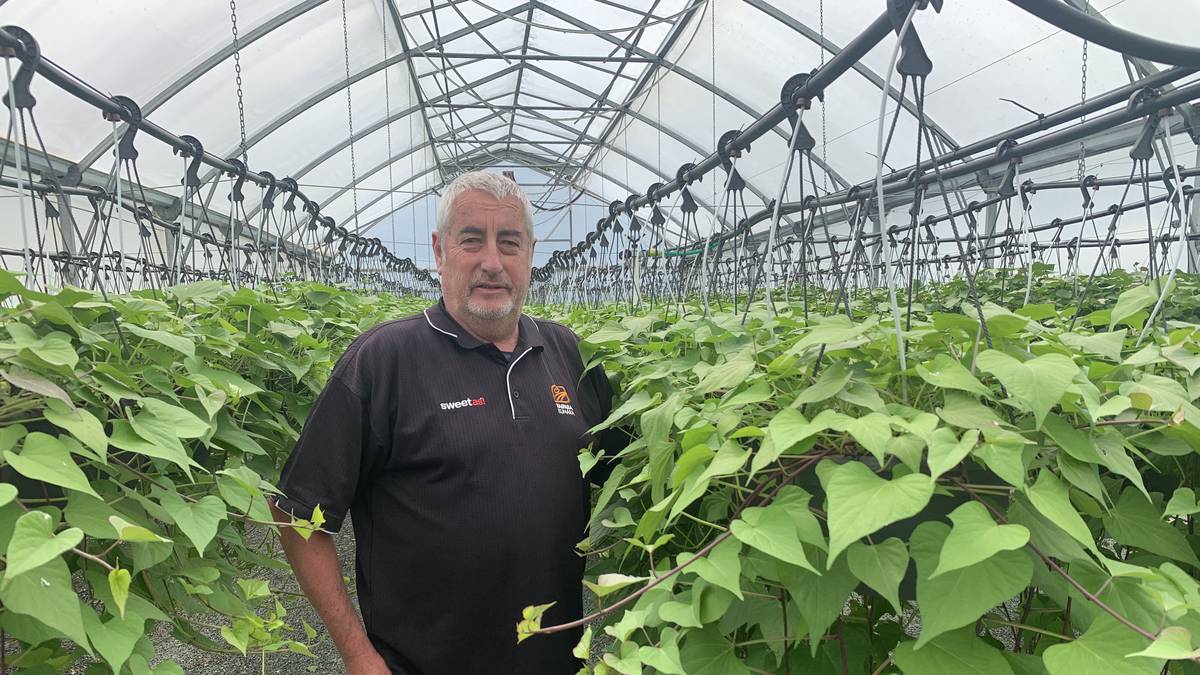Kaipara Kumara managing director Anthony Blundell said next year’s kumara crop was “looking awful” due to heavy rainfall since November this year.
Continuous sodden weather in Northland has “annihilated” the region’s kumara crops, with one grower warning of price hikes on the way for consumers next year.
Heavy rain has severely delayed growers’ planting programmes, with healthy
young kumara plants having to be thrown away as there are no dry fields to plant them in.
This means Northland growers will likely experience a lower yield and delayed harvest next year.
Kaipara Kumara managing director Anthony Blundell said next year’s kumara crop was “looking awful”.
With the normal planting period for kumara being October to December, the planting programme has been “annihilated”, he said.
At mid-December, the kumara industry would usually have around 85 to 90 per cent of the crop planted, whereas currently, it’s around 50 per cent tops.
“The unprecedented level of rain has not been seen before by our kumara industry – and this comes from growers that have been growing kumara for over 50 years.
“We just had another 50 – 70 millimetres of rain over the weekend up here, and more rain is forecast later this week.
Advertisement
“This will likely mean another potential seven or more days of planting will be lost.”
Kaipara Kumara supports Northland growers with product development, growing, storage, packing and marketing assistance and distribution arrangements throughout New Zealand.
The company emailed key customers and associates on November 12 warning the kumara crop quality is likely to be “very average” in 2023 due to the wet conditions which were almost “swamp-like”.
/cloudfront-ap-southeast-2.images.arcpublishing.com/nzme/BQHUM3E3UBFFVBAIRUOSRQJCFA.jpg)
Blundell said growers will have no option but to plant in January, which will mean the yield won’t be as good come harvest time, now likely to be late May.
“It’s one of the worst years we’ve had, for sure.
“When it comes to the 2023 crop, you can’t get any worse than this planting period.”
Blundell said growers will have a clearer picture in January as to what acreage ends up getting planted.
“The best estimate at this stage… 2023′s total harvested crop volume will be between 25 – 40 per cent down on 2022.
Advertisement
“If it pours with rain in January, February and March we could be down a horrendous amount. But growers are pretty resilient; what else can you do?”
Northland has recorded its wettest November on record, with more than five times the monthly average falling over the region.
/cloudfront-ap-southeast-2.images.arcpublishing.com/nzme/IZOVGSQBR5B7DGJLREMGQ74F2A.JPG)
As the La Niña weather pattern and a marine heatwave develop around the country, Northland looks set for a humid and wet summer.
Northern Wairoa Vegetable Growers Association president Doug Nilsson said the planting season had been “terrible”.
“It’s the worst I can remember as far as trying to get crops in the ground.
“Some growers have barely got started.
“Industry-wise, it’s certainly going to be down.
“I’m 60 per cent planted and probably going to struggle on to plant 75 per cent of what I normally plant.
“What I have planted has been significantly impacted by the weather, so the yield is going to be cut in half.”
Nilsson said consumers could expect the cost of the sweet potato to increase next year.
Growers had been selling kumara “way under the cost of production” for the last two years, and they were all struggling, he said, adding that diesel, fertiliser and labour costs were all increasing as well.
“We’ve got three big costs, and selling kumara at below cost is making things tough.
“Prices are going to have to go up to make growing kumara financially viable.”
/cloudfront-ap-southeast-2.images.arcpublishing.com/nzme/LSLBENUMWJGVDE7HL7S72V4BMM.jpg)
Whangārei Growers Market co-founder Murray Burns said it’s “hard going”.
“You can’t get any work done, you’re walking around in mud all day; the plants are all stretched because there’s no sunshine, which makes them more susceptible to disease.
“It’s not a hurricane disaster, but it’s not easy… there’s no sunshine, it’s constant rain.”
Marion Wooster said the weather has had a “big impact” on Orira Orchards, which she runs with her husband John and daughters Tammy and Nicole.
Continuous wind and rain in the Hokianga has hammered the stone fruit, particularly the peaches and nectarines, she said.
“A lot of the blossoms haven’t set because of the bad weather.
“We’ll still do okay, because we’ve got a big place, but we’ve lost over half of the early stuff.
“We still have a lot of apples, but certain varieties have been affected.”
Wooster said she would “love the weather to improve and the wind to drop”.
“Certain varieties of fruit actually like this weather.
“It is what it is – if you’re growing you have to take the good with the bad.
“If you’re in this game, you have to try again next year.”



